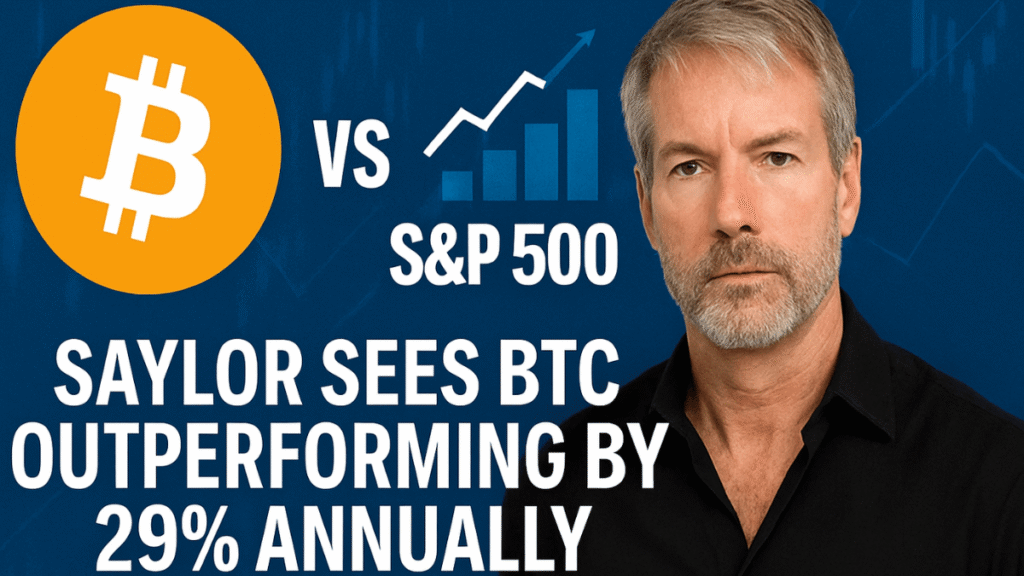Michael Saylor, co-founder and executive chairman of MicroStrategy, has made another headline-grabbing prediction:
“Bitcoin will outperform the S&P 500 by nearly 29% annually for the next 20 years.”
He made the statement in a Coin Stories interview (September 2025), describing Bitcoin as “digital capital”—a scarce, decentralized asset that appreciates faster than stocks or fiat currencies.
This is not just theory. Since 2020, MicroStrategy has accumulated over 638,500 BTC, worth tens of billions of dollars, making it the largest corporate holder of Bitcoin globally.
But can Bitcoin truly outperform the world’s most trusted stock index? Let’s explore.
Bitcoin vs S&P 500: The Numbers
The S&P 500—a basket of the 500 largest U.S. companies—has historically returned about 8–10% per year. It’s widely seen as the benchmark for long-term investing.
Bitcoin, however, has a different story:
- Over the past decade, BTC has delivered annualized returns above 100%, despite volatility.
- In 2023 alone, Bitcoin gained over 150%, compared to the S&P’s ~24% rise (source: Yahoo Finance).
- Even factoring in major crashes (2018, 2022), Bitcoin has consistently recovered and surpassed stock performance.
Saylor’s 29% outperformance projection is based on this historical trend.
Why Saylor Believes Bitcoin Will Dominate
Saylor highlights several reasons why Bitcoin could outpace equities over the next 20 years:
1. Fixed Supply (21 Million Cap)
Unlike stocks or fiat currencies, Bitcoin’s supply is capped. Scarcity + growing demand = long-term appreciation.
2. Hedge Against Inflation
Central banks print money, devaluing currencies. Bitcoin operates independently of monetary policy, making it attractive in inflationary times.
3. Institutional Adoption
BlackRock, Fidelity, and other financial giants are pushing Bitcoin ETFs. Corporates like Tesla and Square have already added BTC to balance sheets.
4. Financial Infrastructure
Saylor sees Bitcoin as the foundation for a new credit system: Bitcoin-backed loans, long-term corporate financing, and even sovereign reserves.
5. Global Accessibility
Bitcoin is borderless, runs 24/7, and doesn’t depend on Wall Street. This makes it appealing for countries with weaker currencies (e.g., Kenya, Nigeria, Argentina).
The Risks and Criticisms
Of course, Saylor’s claim is not without pushback.
- Volatility: Bitcoin can drop 70% in a bear market. The S&P 500 rarely sees such steep declines.
- Regulation: Governments worldwide are tightening crypto rules. Kenya recently introduced the Finance Act 2023 digital tax, showing how regulatory changes can affect adoption.
- Competition: Ethereum, stablecoins, and central bank digital currencies (CBDCs) could challenge Bitcoin’s dominance.
- Corporate Skepticism: Not all CFOs are ready to move company reserves into BTC, especially with accounting rules still evolving.
What This Means for Investors
As someone who has traded since 2015, I’ve seen both sides of Bitcoin’s extreme cycles. For investors, here’s the key takeaway:
- The S&P 500 is still safer, less volatile, and diversified.
- Bitcoin offers higher potential upside but comes with higher risk.
- The smart approach may be diversification—a portfolio mix where Bitcoin complements traditional stocks.
For African investors especially, Bitcoin also acts as a hedge against currency depreciation. In countries like Kenya or Nigeria, where inflation and weak currencies erode savings, Bitcoin can preserve value better than the local stock exchange.
Bitcoin as the “New Oil”?
Saylor often compares Bitcoin today to the early oil industry. In the early 20th century, oil reserves were misunderstood and undervalued—but those who invested early reaped generational wealth.
Bitcoin, he argues, is at a similar stage. Corporations and governments that accumulate BTC now may control a vital financial resource in the future.
A Balanced Outlook
Saylor’s 29% prediction may sound extreme, but he is betting on long-term structural changes. As a trader who has watched Bitcoin evolve since 2015, here’s my perspective:
- He’s right about scarcity. Bitcoin’s supply is unique in finance.
- But 29% annually for 20 years is optimistic. As the market matures, growth will likely slow.
- The real opportunity lies in adoption. If corporations, governments, and investors treat BTC as a reserve asset, the growth story could continue for decades.
In short: Bitcoin may not replace the S&P 500, but it could stand alongside it as a primary investment vehicle.
Conclusion
Michael Saylor’s prediction that Bitcoin will outperform the S&P 500 by 29% annually is bold, but not baseless. Bitcoin’s fixed supply, decentralized nature, and historical performance give it unique advantages over stocks and fiat currencies.
For investors, the choice is not Bitcoin or S&P 500—but rather how to balance both. Stocks remain stable, but Bitcoin offers growth potential and a hedge against global inflation.
One thing is clear: Bitcoin is no longer a fringe asset. It’s shaping up to be the digital capital of the future, and investors cannot afford to ignore it.


Our Editorial Desk – Focuses on forex trading, gold (XAU/USD), and commodities that move the markets. Our editorial desk blends human insight with AI-powered research to produce sharp, actionable content. We aim to help traders make informed decisions with unbiased market coverage.
